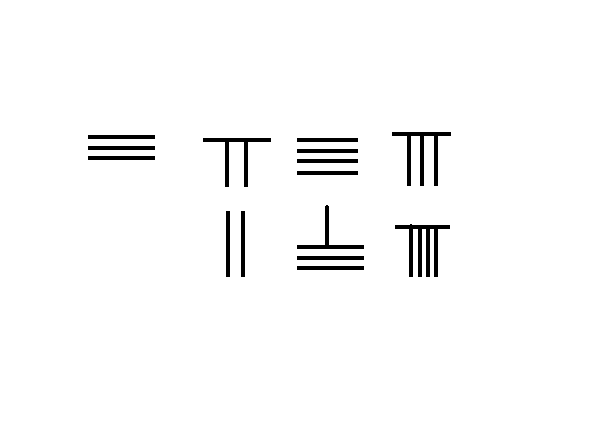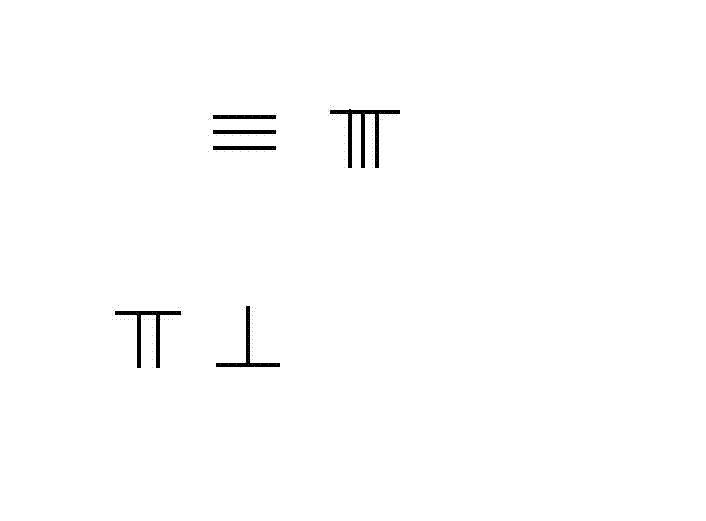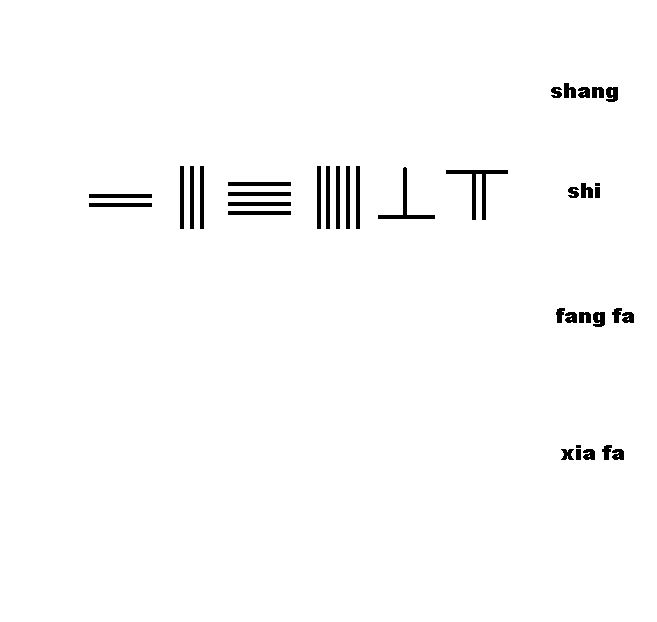Principles of Hindu Reckoning on:
[Wikipedia]
[Google]
[Amazon]
 ''Principles of Hindu Reckoning'' (''Kitab fi usul hisab al-hind'') is a
''Principles of Hindu Reckoning'' (''Kitab fi usul hisab al-hind'') is a

 Kushyar ibn Labban described in detail the addition of two numbers.
The Hindu addition is identical to rod numeral addition in
Kushyar ibn Labban described in detail the addition of two numbers.
The Hindu addition is identical to rod numeral addition in

 In the 3rd section of his book, Kushyar ibn Labban provided step by step algorithm for subtraction of 839 from 5625. Second row digits remained in place at all time. In rod calculus, digit from second row was removed digit by digit in calculation, leaving only the result
in one row.
In the 3rd section of his book, Kushyar ibn Labban provided step by step algorithm for subtraction of 839 from 5625. Second row digits remained in place at all time. In rod calculus, digit from second row was removed digit by digit in calculation, leaving only the result
in one row.

 Kushyar ibn Labban multiplication is a variation of Sunzi multiplication.
Kushyar ibn Labban multiplication is a variation of Sunzi multiplication.

 Besides the totally identical format, procedure and remainder fraction, one telltale sign which discloses the origin of this division algorithm is in the missing 0 after 243, which in true Hindu numeral should be written as 2430, not 243blank; blank space is a feature of rod numerals (and abacus).
Besides the totally identical format, procedure and remainder fraction, one telltale sign which discloses the origin of this division algorithm is in the missing 0 after 243, which in true Hindu numeral should be written as 2430, not 243blank; blank space is a feature of rod numerals (and abacus).

 Kushyar ibn Labban described the algorithm for extraction of square root with example of
Kushyar ibn Labban square root extraction algorithm is basically the same as Sunzi algorithm
The approximation of non perfect square root using Sunzi algorithm yields result slightly higher than the true value in decimal part, the square root approximation of Labban gave slightly lower value, the integer part are the same.
Kushyar ibn Labban described the algorithm for extraction of square root with example of
Kushyar ibn Labban square root extraction algorithm is basically the same as Sunzi algorithm
The approximation of non perfect square root using Sunzi algorithm yields result slightly higher than the true value in decimal part, the square root approximation of Labban gave slightly lower value, the integer part are the same.
The Development of Hindu-Arabic and Traditional Chinese Arithmetic, Chinese Science 13 1996, 35-54
Indian mathematics Hindu Reckoning,Principles of
mathematics
Mathematics is an area of knowledge that includes the topics of numbers, formulas and related structures, shapes and the spaces in which they are contained, and quantities and their changes. These topics are represented in modern mathematics ...
book written by the 10th- and 11th-century Persian mathematician Kushyar ibn Labban Abul-Hasan Kūshyār ibn Labbān ibn Bashahri Daylami (971–1029), also known as Kūshyār Daylami ( fa, کوشیار دیلمی), was an Iranian mathematician, geographer, and astronomer from Daylam, south of the Caspian Sea, Iran.
Career
His ...
. It is the second-oldest book extant in Arabic about Hindu arithmetic using Hindu-Arabic numerals
Arabic numerals are the ten numerical digits: , , , , , , , , and . They are the most commonly used symbols to write decimal numbers. They are also used for writing numbers in other systems such as octal, and for writing identifiers such as ...
( ० ۱ ۲ ۳ ۴ ۵ ۶ ۷ ۸ ۹), preceded by ''Kibab al-Fusul fi al-Hisub al-Hindi'' by Abul al-Hassan Ahmad ibn Ibrahim al-Uglidis, written in 952.
Although Al-Khwarzimi also wrote a book about Hindu arithmetic
Arithmetic () is an elementary part of mathematics that consists of the study of the properties of the traditional operations on numbers— addition, subtraction, multiplication, division, exponentiation, and extraction of roots. In the 19th ...
in 825, his Arabic original was lost, and only a 12th-century translation is extant. Kushyar ibn Labban did not mention the Indian sources for ''Hindu Reckoning'', and there is no earlier Indian book extant which covers the same topics as discussed in this book. ''Principles of Hindu Reckoning'' was one of the foreign sources for ''Hindu Reckoning'' in the 10th and 11th century in India. It was translated into English by Martin Levey and Marvin Petruck in 1963 from the only extant Arabic manuscript at that time: Istanbul, Aya Sophya Library, MS 4857 and a Hebrew translation and commentary by Shālôm ben Joseph 'Anābī.
Indian dust board
Hindu arithmetic was conducted on a dust board similar to the Chinesecounting board
The counting board is the precursor of the abacus, and the earliest known form of a counting device (excluding fingers and other very simple methods). Counting boards were made of stone or wood, and the counting was done on the board with beads, ...
. A dust board is a flat surface with a layer of sand and lined with grids. Very much like the Chinese counting rod numerals, a blank on a sand board grid stood for zero, and zero sign was not necessary. Shifting of digits involves erasing and rewriting, unlike the counting board.
Content
There is only one Arabic copy extant, now kept in the Hagia Sophia Library in Istanbul. There is also a Hebrew translation with commentary, kept in theBodleian Library
The Bodleian Library () is the main research library of the University of Oxford, and is one of the oldest libraries in Europe. It derives its name from its founder, Sir Thomas Bodley. With over 13 million printed items, it is the sec ...
of Oxford University
Oxford () is a city in England. It is the county town and only city of Oxfordshire. In 2020, its population was estimated at 151,584. It is north-west of London, south-east of Birmingham and north-east of Bristol. The city is home to the ...
. In 1965 University of Wisconsin Press published an English edition of this book translated by Martin Levey and Marvin Petruck, based on both the Arabic and Hebrew editions. This English translation included 31 plates of facsimile of original Arabic text.
''Principles of Hindu Reckoning'' consists of two parts dealing with arithmetics in two numerals system in India at his time.
* Part I mainly dealt with decimal algorithm of subtraction, multiplication, division, extraction of square root and cubic root in place value Hindu-numeral system. However, a section on "halving", was treated differently, i.e., with a hybrid of decimal and sexagesimal numeral.
The similarity between decimal Hindu algorithm with Chinese algorithm in Sunzi Suanjing
''Sunzi Suanjing'' () was a mathematical treatise written during 3rd to 5th centuries AD which was listed as one of the Ten Computational Canons during the Tang dynasty. The specific identity of its author Sunzi (lit. "Master Sun") is still ...
are striking, except the operation halving, as there was no hybrid decimal/sexagesimal calculation in China.
* Part II dealt with operation of subtraction, multiplication, division, extraction of square root and cubic root in sexagesimal
Sexagesimal, also known as base 60 or sexagenary, is a numeral system with sixty as its base. It originated with the ancient Sumerians in the 3rd millennium BC, was passed down to the ancient Babylonians, and is still used—in a modified form ...
number system. There was only positional decimal arithmetic in China, never any sexagesimal arithmetic.
* Unlike Abu'l-Hasan al-Uqlidisi's ''Kitab al-Fusul fi al-Hisab al-Hindi'' (''The Arithmetics of Al-Uqlidisi'') where the basic mathematical operation of addition, subtraction, multiplication and division were described in words, ibn Labban's book provided actual calculation procedures expressed in Hindu-Arabic numerals.
Decimal arithmetics
Addition
Sunzi Suanjing
''Sunzi Suanjing'' () was a mathematical treatise written during 3rd to 5th centuries AD which was listed as one of the Ten Computational Canons during the Tang dynasty. The specific identity of its author Sunzi (lit. "Master Sun") is still ...
There was a minor difference in the treatment of second row, in Hindu reckoning, the second row digits drawn on sand board remained in place from beginning to end, while in rod calculus, rods from lower rows were physically removed and add to upper row, digit by digit.
Subtraction
Multiplication
Division
Professor Lam Lay Yong discovered that the Hindu division method describe by Kushyar ibn Labban is totally identical to rod calculus division in the 5th-century ''Sunzi Suanjing
''Sunzi Suanjing'' () was a mathematical treatise written during 3rd to 5th centuries AD which was listed as one of the Ten Computational Canons during the Tang dynasty. The specific identity of its author Sunzi (lit. "Master Sun") is still ...
''.
Divide by 2
Divide by 2 or "halving" in Hindu reckoning was treated with a hybrid of decimal and sexagesimal numerals: It was calculated not from left to right as decimal arithmetics, but from right to left: After halving the first digit 5 to get 2, replace the 5 with 2, and ''write 30 under it'': :::::::: 5622 :::::::: 30 Final result: ::::::::: 2812 ::::::::: 30Extraction of square root
Sexagesimal arithmetics
Multiplication
The Hindu sexagesimal multiplication format was completely different from Hindu decimal arithmetics. Kushyar ibn Labban's example of 25 degree 42 minutes multiplied by 18 degrees 36 minutes was written vertically as :::::::::::::: 18, , 25 :::::::::::::: 36, , 42 with a blank space in betweenInfluence
Kushyar ibn Labban's ''Principles of Hindu Reckoning'' exerted strong influence on later Arabic algorists. His student al-Nasawi followed his teacher's method. Algorist of the 13th century,Jordanus de Nemore
Jordanus de Nemore (fl. 13th century), also known as Jordanus Nemorarius and Giordano of Nemi, was a thirteenth-century European mathematician and scientist. The literal translation of Jordanus de Nemore (Giordano of Nemi) would indicate that he w ...
's work was influenced by al-Nasawi. As late as 16th century, ibn Labban's name was still mentioned.Note by Martin Levey and Marvin Petruck to ''Principles of Hindu Reckoning'' pp 40–42.
References
External links
*{{CommonscatinlineThe Development of Hindu-Arabic and Traditional Chinese Arithmetic, Chinese Science 13 1996, 35-54
Indian mathematics Hindu Reckoning,Principles of